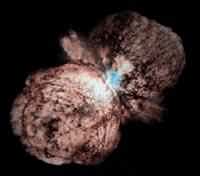|
|
First | Previous | Next | Last | | Index | Home Slide 15 of 49 During the first few minutes after the creation event the basic elemental nature of the universe was fixed. During these few minutes the universe was hot enough to support nuclear fusion. The amount of fusion and the kinds of elements formed was a function of the mass of the universe. At this time 24% of the hydrogen was fused to form helium. In addition, very small amounts of heavier elements were formed. Both of these facts are significant. The presence of helium in the cores of stars makes nuclear burning much more efficient than it would be without it. If the universe were much smaller than it is, no helium would have been formed during the initial few minutes of the Big Bang. As a result, the universe would have consisted solely of hydrogen, which would have prevented the formation of stars and galaxies capable of supporting life. If the universe were much more massive, too much of the hydrogen would have fused to form heavier elements, likewise preventing star formation, and resulting in a universe filled with black holes only. We live in a just right sized universe for life to exist. Atheists have often stated that the universe is too large if humans were the sole purpose for the existence of the universe. However, science tells us that if the universe were much smaller, human life would not be possible. The amount of heavy elements formed during the Big Bang was insufficient to allow for the formation of rocky planets (like the Earth) at any time during the history of the universe. However, the design of the laws of physics are such that God provided a way for rocky planets to be formed. These heavy elements are formed in the furnaces of stars during their lifetimes and during supernova events. Stars at least four times more massive than the Sun undergo rapid, hot burning, which culminates in a spectacular explosion, called a supernova. In this manner, the heavy elements necessary for rocky planet formation are scattered throughout the area. Many of these supernova events are required within a galaxy for enough heavy elements to be available for the next generation of stars. However, supernova must not occur in the vicinity of life-containing planets, or else all life would be extinguished as a result of the radiation produced, which is enormous. Earlier this year, there was a gamma ray burst from another galaxy that was powerful enough to temporarily knock out satellites in orbit and give each person on the surface of the Earth the equivalent radiation of a chest X-ray. Obviously, any life present exposed to the gamma ray burst in that galaxy would have been destroyed by radiation levels millions of times higher than what we received at this great distance. |
http://www.godandscience.org/love/sld015.html
Last updated March 31, 2008

